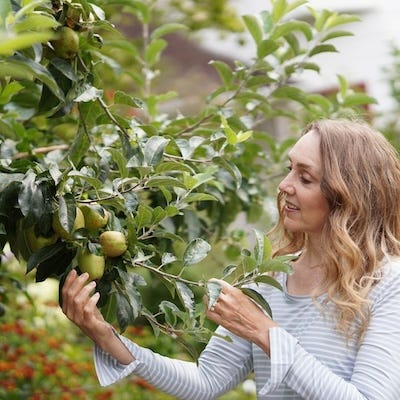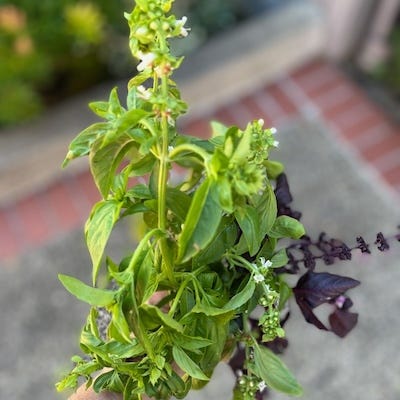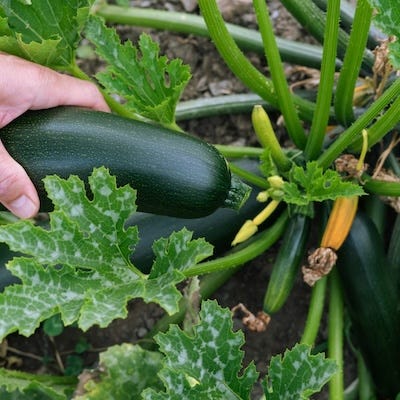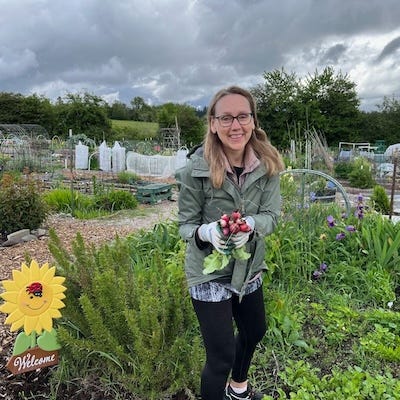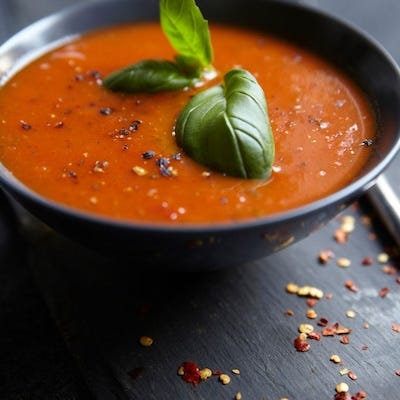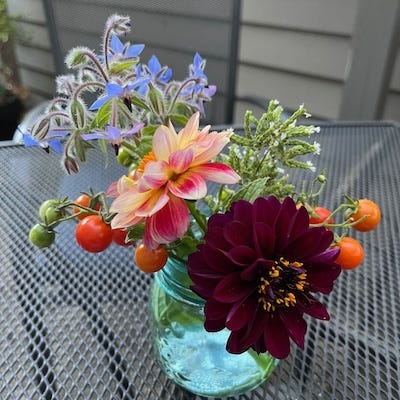The first time I experienced better-tasting produce …
I remember loving apples as a kid. I ate them all the time.
I continued the habit, and still eat apples regularly. But somewhere along the way, I forgot how much flavor they can have.
Until I moved to the Pacific Northwest. Home to more than 30 varieties of apples, many you’ll never find in large grocery stores.
I fell in love with a greenish-yellow apple with red flesh and a deliciously tart flavor. Mmm… the burst of flavor was something reminiscent of when I was a child.
Could apples actually have that much taste?! Amazing!
It wasn’t just apples. I started noticing that when I visited organic farmers and purchased items picked only a day or two before, the flavor was out of this world. Like nothing I’d tasted in a very long time.
Radishes. Cucumbers. Berries. Pears. They all had FLAVOR.
I’d forgotten just how good food can be.
Why?
Probably the biggest reason is ripeness. When you let food ripen on the vine, it allows full flavor potential. To be picked, boxed and shipped takes time - they pick it early, before the flavor settles in.
Big stores buy in masses. They don’t want options - they want guarantees. They want food to last a long time - as long as fresh produce can. So they limit the varieties and only ship/buy long-lasting foods they have a better chance of selling.
And increasingly, I’m finding that flavor and chemicals just don’t mix. When you grow locally, in smaller quantities, you don’t have to rely on synthetic pesticides or fertilizers. Organic farmers are discovering other methods to produce healthy, good-tasting food. Yet BIG farmers are still pushing for chemicals.
Enough!
I think it was only natural I would someday have the desire to grow my own food. Not all of it. But enough to have fun with it during the growing season.
Because when you taste the difference, you want more. Why not grow it yourself?
Start a garden for the fun of it
I knew I wanted to grow more myself. But I live in a house without a lot of land. We have a patio, a small deck, and very little sun. (I love living under the canopy, but it doesn’t offer a lot of growing options.)
I planted a few baskets and buckets, and was able to bring a few things into my kitchen. But I wanted more!
Then, I found my community garden. And I started having fun. Quite honestly, this is what gardening is all about.
It’s about bringing home produce - because the food tastes better.
But it’s also about connecting with the land. Having dirt run through your fingers. Picking fruits and veggies you know are going to taste better, because you grew them.
And, of course, a community. With more than 200 plots, there’s always somebody there, ready to answer questions. They offer classes and all kinds of opportunities to be a bigger part of this community.
It’s fun! (And it’s a GREAT way to spend the summer!)
Even with all of these resources, I’m constantly looking for help online. And there’s a ton.
I was recently inspired by The Joyful Gardner, who is offering a Grow Your Own Vegetables class. In her guide, she says:
“Remember your garden won’t always look perfect, as nature has seasons, but your masterpiece will emerge more with each passing season.”
I believe there isn’t a right or wrong way to garden. It’s about doing it and finding joy in the process. I’ve planted hanging baskets with edible flowers to make my salads gorgeous. I’ve grown herbs on my windowsill. And now I have a plot in a community garden.
Each step brought me to where I need to be today. Because I find the thrill of being where I am in the food supply. It’s fun!
Where would you like to start?
Start a garden to have healthier food
Want healthier food? Grow it yourself!
I believe chemicals shouldn’t be in our food supply. They shouldn’t be injected into the seed, nor should the plant be continually sprayed throughout the lifecycle without expecting detrimental results. Times are changing, and the courts are starting to agree. But with so much damage already done, sometimes it feels better to take matters into your own hands.
Once upon a time, anyone who grew anything in a garden could easily gather seeds at harvest time and save them for the following year. Or you could buy produce, harvest the seeds, and plant them next year.
It doesn’t quite work that way anymore.
Store-bought veggies are often hybridized, meaning they are created from different varieties of the same plant designed for a specific purpose. They can’t be used for production.
You can try to find non-hybridized, but that’s difficult to do. And if you do, these overly ripe veggies often don’t have the best seeds. - they aren’t worth saving.
This is where it gets fun to find seeds you can use and grow year after year.
Heirloom seeds are seeds saved and grown for decades, possibly centuries. This is where you can find unusual varieties that you’ll NEVER find in the markets.
This isn’t just veggies and fruit - look for flowers and herbs too. Try SeedSavers and Annie’s Heirloom Seeds - even looking through their catalogs is fun!
Start a garden to be outside
In the Pacific Northwest, there’s a strong possibility of rain all winter long. As spring turns into summer, the chance of rain falls to almost nothing. It can go weeks - months - with little rain.
And while rain is good 😉 - I LOVE the sun! I look for any excuse to get out of the house and into the sunshine.
A garden makes it that much easier.
I remember planting a zucchini plant our first year. We pushed everything too close together, and it made finding veggies a little tricky. It’s amazing how fast zucchinis grow when you don’t notice them for a few days!
Honestly, nothing feels better than walking through the garden daily and seeing how much life there is - things can grow FAST. And you pay attention to something new - taking notes along the way. (I no longer plant plants so close together.)
And oh, when you finally start harvesting. I’m sometimes overwhelmed by how much food can grow overnight.
I found the secret of carrying your bounty home last year … trugs. A trug is a shallow gardening basket traditionally made from wide strips of wood. I also use plastic baskets like these - I love this one as I can drop it in my sink and spray the whole thing down. These are cool, too, because you can stack them anywhere.
Start a garden to reduce stress
Stress relief. It’s something we all have waayyy too much of, and most of us are looking for ways to let some of it go.
I dare you to hold onto it in a garden.
Honestly, you can’t garden incorrectly. I had a goal for my first year to “grow one thing I can eat.” In a few short weeks, a radish popped up, and I tasted the first fruits of my labor.
It was spectacular! I couldn’t help but smile.
Of course, I got a lot more than one radish. And I LEARNED! Nothing was perfect, but I couldn’t help but let everything go when I pulled a few weeds, sprayed water over my plants, or picked a veggie for dinner.
This year, I’ve doubled my plot size, so I’m adding flowers to my garden. I’ve had my eye on this for collecting them and bringing them home to put on my table and my desk. What do you think?
Start a garden to connect with nature
My cure for anything is to go outside and get in touch with nature. I walk daily by the river, breathing in nature all around me.
Years ago, I watched a show where they taught inner-city families the importance of nutrition and cooking. In the beginning, many kids and adults had no idea what common fruits and veggies were - they didn’t know their names, had never seen them. Instead, they relied on fast food.
I’ve never forgotten that. And every year, I get a deeper understanding of just how important nature is, and how we’re connected to this earth.
Someone I’ve been learning from for several years says it best.
Start a garden for the sense of accomplishment
Nothing feels better than completing a project from beginning to end. You handle every aspect of it, see it through, and feel GREAT when it’s finished.
A garden is the perfect place for that.
I really feel that towards the end of the summer when I have produce piling up in every corner of my kitchen.
I choose seeds or starters. I plant them. Water them. Nourish them. Then find a recipe that lets me feel the flavor. It’s so good!
Like a simple tomato soup. It’s super easy!
Fill a baking tray with sliced, vine-ripened tomatoes. Mix in several cloves of garlic, a chopped yellow onion, and a red or green pepper. Roast for 45 minutes or so until lightly browned. Put them in a large pot with some veggie broth, and add herbs you grew in your garden. Mix it together with an immersion blender, and voila, dinner is served!
I quite honestly can’t survive without my immersion blender - I’d recommend adding one to your plant-powered kitchen. You’ll reach for it repeatedly as you cook.
Start a garden for family bonding
My husband and I jumped at the chance of growing a garden. I loved the fact that my adult daughter went all-in, too. It’s so much easier having three people to go back and forth and control it. And we’ve noticed it’s quite common in our community garden.
Almost every plot has an interesting story.
Like the family that’s teaching their preteens the importance of gardening.
Or the two sisters that are growing it together.
A family that gardens together, stays together. (I know, not the actual quote, but it’s true!)
If you want to let everyone have their say in what to grow, I’d suggest starting with a garden planner. Gardeners has pre-planned garden plans to select from, or build your own. With lots of advice and resources, it’s a great tool to use as you plot out your own garden.
Start a garden for the joy of gardening
“The glory of gardening: hands in the dirt, head in the sun, heart with nature. To nurture a garden is to feed not just the body, but the soul.” ~Alfred Austin
I’ll admit it; I love gorgeous things. Maybe it’s the photographer in me.
The very first book I created was a coffeetable book called Being a Bride. It was filled with our wedding photography, weaving a detailed story about the dreams a little girl has as she envisions herself being a bride.
I think that’s what started me down the road to collecting gorgeous coffeetable books. It’s led to such memorable books with truly gorgeous photography … and over the last few years, gorgeous flowers.
Try An American in Provence - I adore her stories.
Then I found Cathy B Graham - she combines flowers and veggies and fruit - pure inspiration!
And Floret Farm’s three books are pure inspiration. Yes, I’ll be growing her flowers this year in my expanded garden!
Start a garden to try new things
When you have limited space, you start getting creative with your designs. I was inspired by several YouTubes that showed how easy it was to go up … vertical growing for plots without a lot of room.
Last year, we used simple bamboo teepees for our squash and pumpkins. They caved by the end of the season under too much weight.
So this year, I’m going BIIGGG!
I found step-by-step instructions on building a squash arch. They’re built and ready to go … when the weather gets a little nicer. 😉
Start a garden to nurture all four seasons
Think gardening is just for the summer? Think again.
I know I’m lucky here in the mild climate of the Pacific Northwest. Growing here means crops from March through October, sometimes November.
But even the winter has its place. Cover crops can add nutrients to the soil, and make it oh, so much better come spring.
There’s also a trick to growing so you have a harvest all season long. Don’t plant all at once - plant in stages. You should also plant according to when you want each harvest.
And find resources that offer specific crops.
Like specialty pumpkins.
Gardening has made me appreciate every season a little bit more. To fully relish what each season is for.
I can’t wait for this season!
Lori





